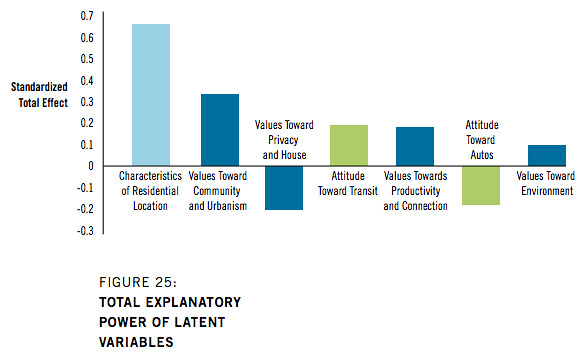
A new national survey released today by TransitCenter seeks to understand not just the who, but also the why, of Americans' increasing transit use. The survey found that Americans' feelings towards transit and cities vary considerably by age, personal values, and whether transit provides a feasible travel option in their neighborhoods. Factors that don't have much of an effect on transit use include having children at home, education level, having very high incomes, and the region of the country people inhabit.
The survey also identified several individual factors strongly linked to transit use. Residents of dense, transit-friendly environment, people with jobs or enrolled in school, people of color, low-income Americans, and people with access to high-quality transit are all more likely to ride transit, echoing previous survey findings.
The TransitCenter survey goes beyond prior research by trying to understand personal characteristics that might motivate transit use. Transit users are likely to have grown up in neighborhoods with convenient transit, to be open to new things and experiences, and to want to remain productive while traveling. These motivations are almost as strong as more basic motivations, like relying on transit because no other options are available.
The survey also reinforces prior research into the kinds of neighborhoods Americans want, finding that Americans generally want a blend of space and walkability, and that there are significant mismatches between the types of places people would like to live, and the places they actually call home. Only 37 percent of respondents who live in suburban residential areas preferred that type of neighborhood, for instance, and only 28 percent of them wanted to live in such a neighborhood as children. Almost half of all respondents (48 percent) wanted to live in mixed-use suburban or small town areas, and more than half of people who live in those areas are satisfied with their locations.
Generations differed sharply in their responses, with 62 percent of people under 30 preferring urban or walkable suburban environments compared to 44 percent of people over 30 who said the same. Interestingly, this is even though millennials were raised in comparatively un-walkable settings: Just 52 percent of respondents under 30 said they could walk or bike to retail shops as children, compared to 69 percent of respondents over 60.

The survey digs deeper than previous research to unearth the attitudes that underlie differences in travel behavior. While some "clusters" of suburban residents show little interest in using transit, the survey also identified segments of urban and suburban residents, comprising 43 percent of all respondents, whose attitudes indicate that they might try transit more frequently. The demographic clusters TransitCenter identifies as "Bohemian Boomers," "Willing and Waiting," and "Metro Moms and Dads" display attitudes consistent with a greater propensity to ride transit.
Notably, the survey found that where people live and why they chose to live there have a greater impact on transit ridership than people's attitudes toward transit or driving. In other words, it's how people view the urban environment, more than the transportation mode itself, that leads them to ride transit or drive cars.
Understanding these sorts of variables isn't just important for understanding the people with you on the train. They're also important for targeting voters for transit ballot measures, understanding the types of neighborhoods that will embrace transit, and helping transit systems better market their services.
The survey aimed to include statistically valid sample sizes for different regions of the country, three age groups (under 30, 30 to 60, and over 60), and across 46 metropolitan areas which have transit systems that are either extensive (e.g., Charlotte, Madison, Portland, Salt Lake City) or limited (e.g., Albuquerque, Fresno, Indianapolis, Richmond). All told, it included 11,846 responses.







